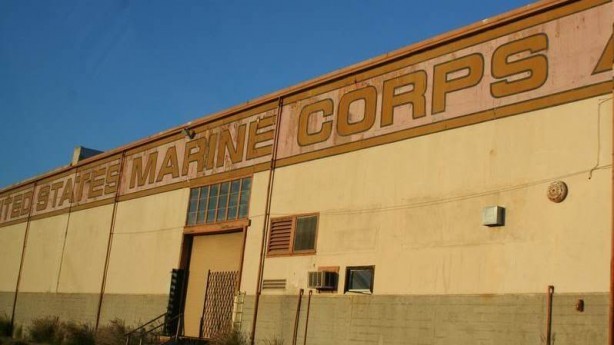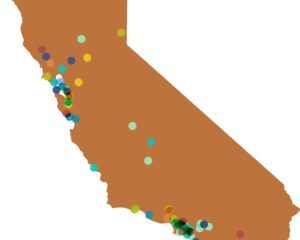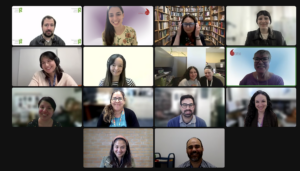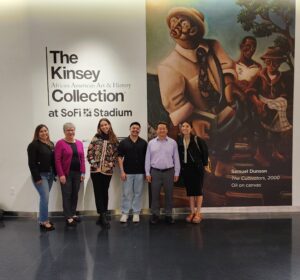The Women of El Toro is a collaboration between Cal State Fullerton (CSUF), the Center for Oral Public History at CSUF, and the Orange County Great Park. This project will raise awareness of women’s roles in the military and enrich visitor’s appreciation of the history and landscape of the park, site of the former El Toro Marine Corps Air station. This project is directed by Christine (xtine) Burroughs, Associate Professor, Communications, and Dan Sutko, Assistant Professor, Human Communication Studies, both at California State University, Fullerton.
Tell us a little about yourselves – background, academic research,
other interests?
We’re excited about The Women of El Toro because it presents an opportunity for us to bring together our complementary backgrounds in digital media arts and invent a platform that will amplify women’s voices captured by the Center for Oral and Public History (COPH) at Cal State Fullerton.
xtine is a new media artist and educator. She has authored or edited several books including Foundations of Digital Art and Design (2013), Net Works: Case Studies in Web Art and Design (2011), and The Routledge Companion to Remix Studies (2015). Informed by the history of conceptual art, she uses social networking, databases, search engines, blogs, and applications in combination with popular sites like Facebook, YouTube, or Mechanical Turk, to create web communities promoting interpretation and autonomy. xtine is passionate about creating works using digital tools to translate common experiences into personal arenas for discovery. She is a Webby Honoree, has received a Terminal commission and an award from the UK Big Lottery fund.
Dan is an assistant professor in digital media at California State University, Fullerton. He studies emerging technology and culture with an emphasis on innovation, government, and social justice. He is currently researching how piracy animates normative understandings of technologies that disenfranchise and marginalize users. He has published in top communication and media journals about mobile technologies, video games, and social theory. He co-edited, with Adriana de Souza e Silva, Digital Cityscapes: Merging Digital and Urban Playspaces, a book on the theory, design, and educational application of location-based mobile games.
What led you to this project – The Women of El Toro?
The Women of El Toro is an iOS application that augments The Great Park in Irvine, CA with excerpts from stories told by female military veterans and military wives who were stationed at the El Toro Marine Air Corp Station in the 1940s (on the same land as what is now The Great Park). Put very simply, and somewhat crudely, it is an audio tour of the park that shifts time (present day in a user’s toured experience with stories of the 1940s in their earbuds) and illustrates a relationship between the stories and park locations. Some of these experiences include: a balloon ride augmented with stories about flight, the farmer’s market with stories about living on a farm or the farm land in Orange County, the kid’s play area with stories about raising children on the base, a reflecting pond with stories about how these women imagine El Toro will be remembered, the administrative building with stories about doing administrative work, and so on.
This project was almost invented backwards. Typically, the selection of stories for a project and grant such as this would come first, and the technology for telling the stories would be determined based on the design of the project. xtine and her partner, Paul, had a vision for the technology on which this project is based years ago but were in search of a specific site of historic interest in order to create the augmented application, as well as a collection of stories. So the idea sat in xtine’s notebook for a while. When Dan joined the CSUF faculty in fall 2014, xtine approached him as a co-PI to investigate the idea with fresh eyes. In a meeting with the grants and funding office at CSUF, Camille Harper mentioned that COPH had an archive of public histories recorded with military veterans from the El Toro base, which is now the Great Park. This work was done during the transition between the base and the park. In about half an instant, Dan suggested using those stories and locating the app at The Great Park; and xtine said: yes, but only female veterans. We met with COPH a day later (directed and assisted all by women) and they were excited to make this part of their archive publicly available. It seemed they were also excited for the feminist framework of the app (as were we!) and to collaborate on a digital humanities project.
What interesting stories have emerged from your research?
For this project, we read a lot of oral history interview transcripts and selected small snippets of stories for various locations in The Great Park. We spent the better part of the fall enacting a close reading of about 80 transcripts, which we estimate to be about 100,000 words. In them, we found a lot of similar themes emerging from the interviews.
A big realization was how the history of El Toro intertwines with the history of Southern California. Many of our interviewees relocated here from the rural Midwest, Eastern, and Southern US for El Toro and ended up staying for the weather and the communities that built up partly around the base. In many ways, the history of El Toro from inception to demilitarized park reflects the history of Southern California and its conversion from rural orange groves to suburban living.
Many shared what it was like to choose to join the Marines—for some who were under age a parent’s signature was required, for others the Marines, rather than the WACS (Women’s Auxiliary Army Corps) or WAVES (Women Accepted for Volunteer Emergency Service) seemed more hardcore (which was not a term these women used, but the feeling or vibe of its seriousness, impact, or commitment was evident). Women stationed at El Toro came from all over the country, some left farms, some left jobs in stores or as book keepers, some came from military families. All were extremely proud to serve their country and remain proud to be a Marine or married to the military. Many of the women shared what it was like to have children and raise a family on and off base. We were surprised to learn, for instance, that when their spouses left El Toro to serve overseas, military wives also had to leave El Toro. Many of them packed their children and returned to their parents’ homes—located all over the country, and waited for their spouses to return before settling down again in El Toro or on a new base, or somewhere else if their spouse was discharged. Our favorite stories illustrated the type of work and treatment the women received at El Toro and the sense of community the women shared on base. There are expected stories, sort of “Private Benjamin” style, for instance, of a woman who scrubbed a bathroom with a toothbrush for speaking out of line; and there are unexpected stories of Marines in the kitchen baking wedding cakes for female Marines who were married during their time on base at El Toro.
What do you hope will result from your project?
We hope to make people more aware of the history of Southern California, the Great Park, El Toro, and the often ignored role of women in the military. Our partners at COPH have made great strides in this area and we are excited to make their archives accessible in a new way to the public. We imagine our app will be used by public visitors to the Great Park, history / culture classes in elementary, high school, and college, as well as people who might not even be in SoCal but are interested in hearing these archives. We’re embedding social cues in the app to encourage users to post responses to social media. We would love to see social activity that extends beyond the park. We’ll then know we’ve reached a public audience that at this point we have only imagined.
We also want to give Great Park visitors a way to explore the park and discover places they might not otherwise visit. The Great Park is beautiful but huge, especially if you’re walking. There are so many reasons to visit the great park but not one experience that ties all the parts of the great park together. Our app gives visitors a fun, interactive way to visit the park and become inspired to come back again after discovering the Food Lab or the athletic fields or the reflecting pond.
Lastly, and we know this is a little selfish, but we hope we’ll get a chance to meet some of the interviewees when we launch the app at the Great Park. We plan to host a picnic for the launch party in late spring and will be posting updates about that.
Why are the humanities important? Why do they matter?
Humanists have long recognized that places, such as The Great Park or El Toro, are the result of individual stories that coalesce to give place a sense of meaning and purpose–to make a house a home or, in this case, a place a space. Prior to digital media, publicly accessing historical and cultural artifacts was limited by protecting and preserving those artifacts in a library or museum and making them available in limited ways. Digital humanities can help us turn the museum and other educational/cultural experiences “inside out” by augmenting the physical world with historical or cultural artifacts without worrying about damage.
We need the humanities because they offer us a chance to reflect on ourselves, individually and collectively. We usually take technological progress as the marker for advancing as a culture, whatever that means, but that happens to the neglect of measuring progress on social justice issues–which is to say moral, ethical, and civil issues. The Women of El Toro documents not only the role of women in the military but also provides background on changing gender roles and gives us a chance to reflect on how far we’ve come and how much further we can go in terms of gender equality.
In sum, the humanities provide insight and opportunity to reflect on the world and realize the potential of every experience to be one that has an impact on our ability to realize our selves more fully, connect with our communities, and deepen our understanding of our relationships with our friends, families, and neighbors. The humanities are like the quiet work of breathing: without it we would suffocate but more often than not we forget that it’s there.





